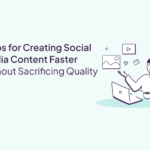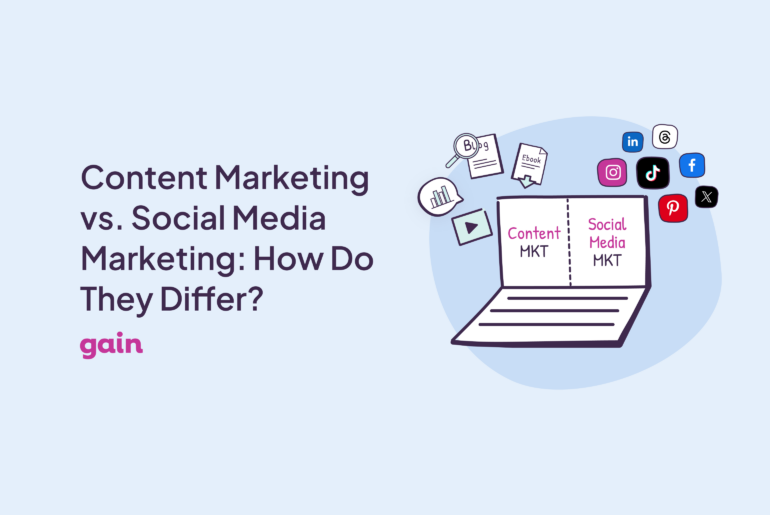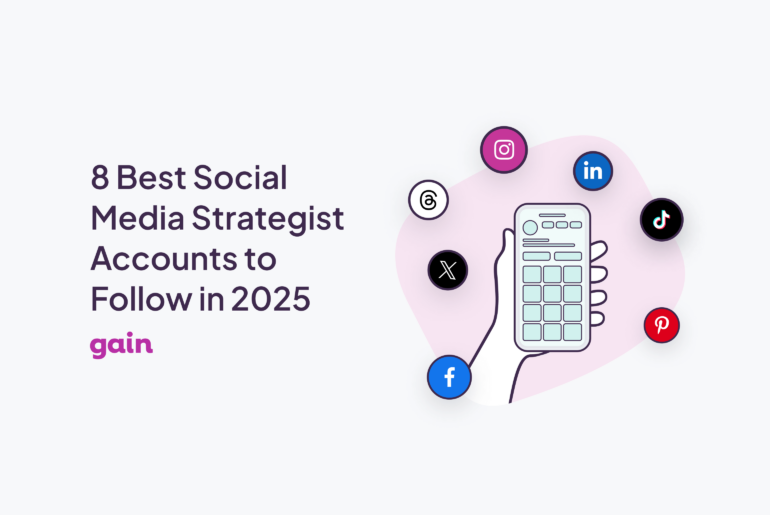Building an impactful social media presence for your clients demands dedication, time, and sometimes a hefty investment. Your clients come to you with underwhelming budgets but want mega results.
While we’re sure you set realistic expectations for your clients, that doesn’t mean you shouldn’t lean into creative ways to maximize content’s value. Content repurposing is a great way to transform existing content into new formats to reach broader audiences across different social media platforms—all without doing work from scratch.
Read on to learn how to build a robust content repurposing workflow that you can use with all your social media clients.
First, What Is Social Media Content Repurposing Workflow?
A social media content repurposing workflow is a process where existing content is modified and reused across various social media platforms to reach a broader audience without creating completely new content each time.
For example, you might turn a long article into a bunch of tweet-sized tips or a video interview into some cool quote pictures for Instagram.
The idea is to maximize the value of content by adapting and sharing it in different formats to suit different social media platforms and their respective audiences.
Content Repurposing vs. Content Recycling
Now, we often hear another term, ‘content recycling,’ used interchangeably with ‘content repurposing.’ But they aren’t quite the same.
Content repurposing is primarily about turning a ‘bigger piece of content’ into something smaller, like an article into a bunch of tweets or a long video into reels.
Content recycling, on the other hand, means taking the same content and sharing it again later. This could be reposting last year’s Easter-themed reel or sharing a popular post to bring in new followers.
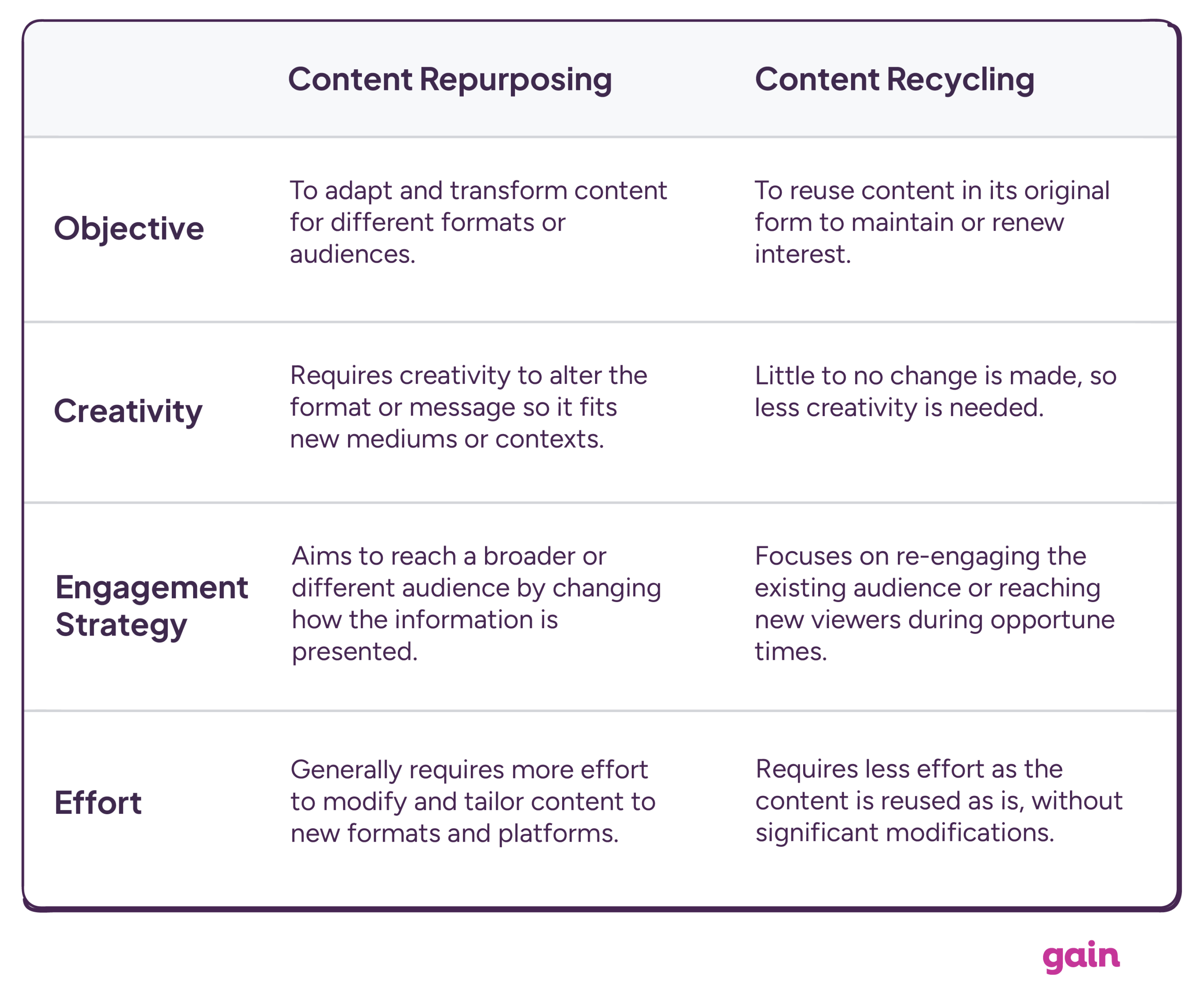
Both strategies are valuable, and they work really well together. Repurposing changes how the content is presented, while recycling brings it back at the right time. Together, they help you maximize your content’s impact and keep your audience interested.
Benefits of Content Repurposing for Social Media Agencies
Repurposing social media content for your clients can offer massive perks for your agency. Here are some of the most important ones:
- Cost Savings: Research by Content Marketing Institute reveals that content creation consumes at least one-fourth of a typical marketing budget. When you repurpose existing content, you can significantly reduce production costs while maintaining a consistent publishing schedule across clients.
- Time Savings: As an agency, creating social media content at scale for multiple clients is no easy feat. Content repurposing, however, can save you a ton of time. About half of marketers agree that recycling their best stuff helps speed things up. When you make repurposing a regular part of your routine, you free up more time to focus on the big-picture activities, like strategizing, audience engagement, and digging into the data.
- Maximized Content ROI: Another great benefit of content repurposing is that it can increase content ROI. By extending the lifespan of valuable content assets, you can maximize your clients’ return on investment which is always a bonus!
So, how do you actually build a solid content repurposing workflow that you can use with all your social media clients? We cover that in the next section.
Step-by-Step Guide to Building a Content Repurposing Workflow
1. Assess Your Client Needs and Existing Content
When juggling multiple clients, each with their own unique goals and target audiences, start your content repurposing journey with a solid assessment. Understanding what resonates with each audience and aligning this with your clients’ objectives sets the stage for impactful social media campaigns.
Look at each client’s audience at a more granular level. Things to consider:
- Demographics
- Preferences
- Behaviors
- Geographic location
Next, review your clients’ existing content. Sift through the content you’ve already created for each client. But don’t just look for hits! Identify evergreen content that can be refreshed and remain relevant over time.
2. Develop a Content Repurposing Plan
With a clear understanding of what your audience wants and what content you already have, it’s time to chart out a plan. As a minimum, your content repurposing plan should include the following:
1. Goals
What are you aiming to achieve with your repurposed content? Is it to increase engagement, boost website traffic, or perhaps elevate brand awareness? Setting specific, measurable goals helps direct your efforts and provides a benchmark for success.
2. Formats
Not all content works well on all platforms. For example, a detailed infographic may shine on Pinterest but could fall flat on Twitter. Think carefully about the different content formats and how well they work on various platforms.
3. Content Calendar
Lastly, map out when and where each piece of content will be published to keep your workflow organized and ensure a consistent presence across all channels. Your content calendar should also be flexible enough to accommodate trending topics or spontaneous content needs that arise from your monitoring efforts.
3. Identify Best-Performing Content
We’ve already touched on this a bit in the first step. However, you may be wondering how exactly you can uncover pieces that have performed well in the past.
Well, it’s no secret that analytics tools will be your best friends in this area. You can use either the native analytics tools available or our tool, Gain.
Gain tracks the performance of your published social media content, allowing you to see which posts have the highest engagement rates, shares, and comments. It works across all connected social media platforms, eliminating the need to log into each one separately. With Gain, you can even export your data into a handy spreadsheet or a PDF report.
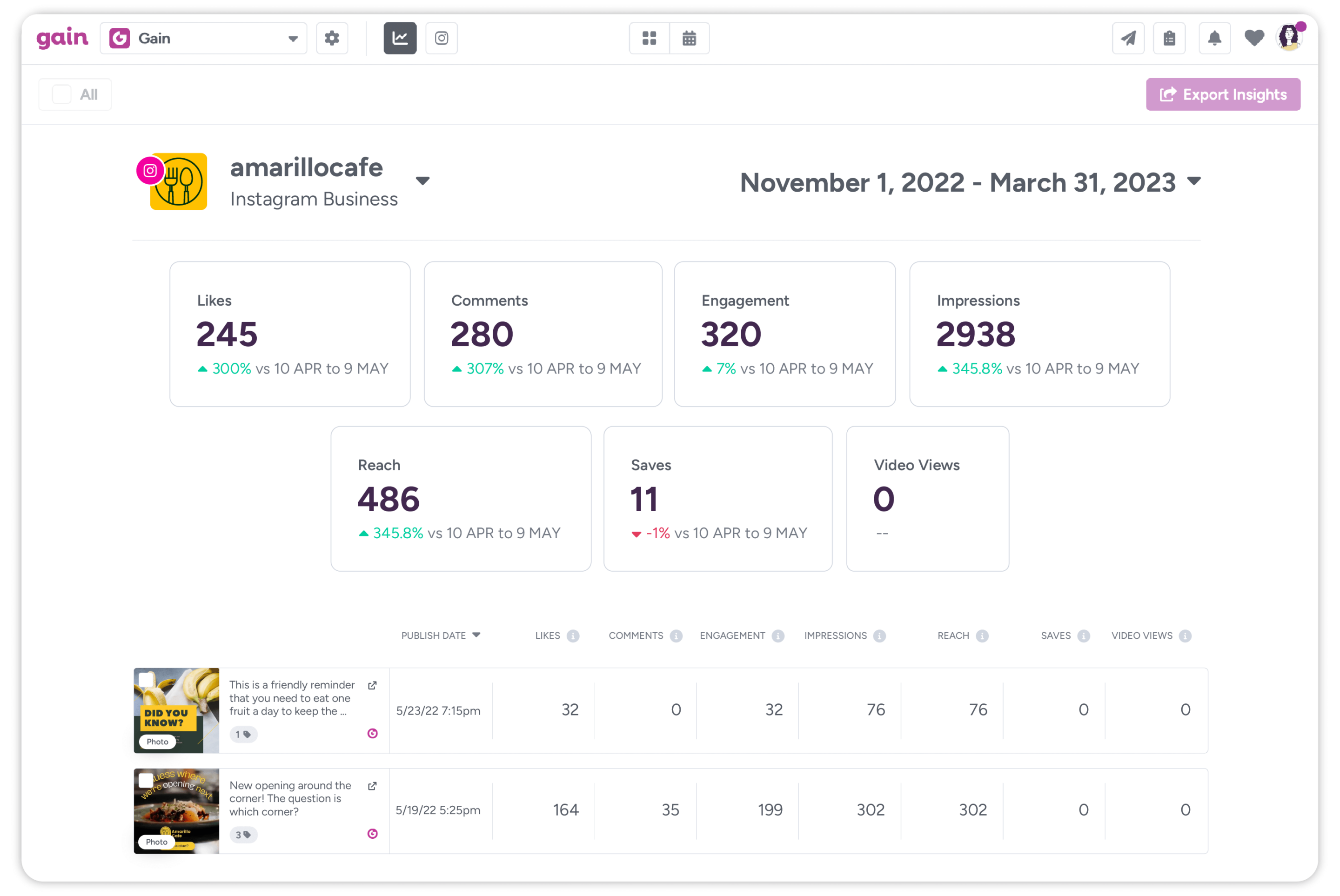
That said, you don’t want to be looking at engagement data only. You also need to consider the content’s potential.
Look for content that has timeless appeal: those how-to articles, thought leadership pieces, or high-impact visuals that can easily be updated or reformatted. Also, consider content that could benefit from being presented in a new way. Perhaps you have a popular podcast episode that can be transformed into an engaging series of short-form videos or a blog post with a bunch of statistics that can be turned into a carousel for LinkedIn.
Bonus tip: Pay attention to current social media trends and seasonal topics that align with your clients’ industries. Repurposing content that taps into these trends can give it a second life and increase its relevance and appeal.
4. Use a Social Media Tool to Speed Up Repurposing
Don’t manually repurpose content—it can take hours to do for all your clients. Instead, most social media management tools that assist with creating, scheduling, and publishing content also offer capabilities for content repurposing and recycling.
For example, with our tool, Gain, you can easily identify your clients’ top-performing content and schedule it to be reused whenever you choose. Plus, Gain lets you quickly duplicate your social media posts across different platforms without the extra effort of adapting them for each one. It’s a time-saver for agencies like yours that manage multiple social media platforms simultaneously.
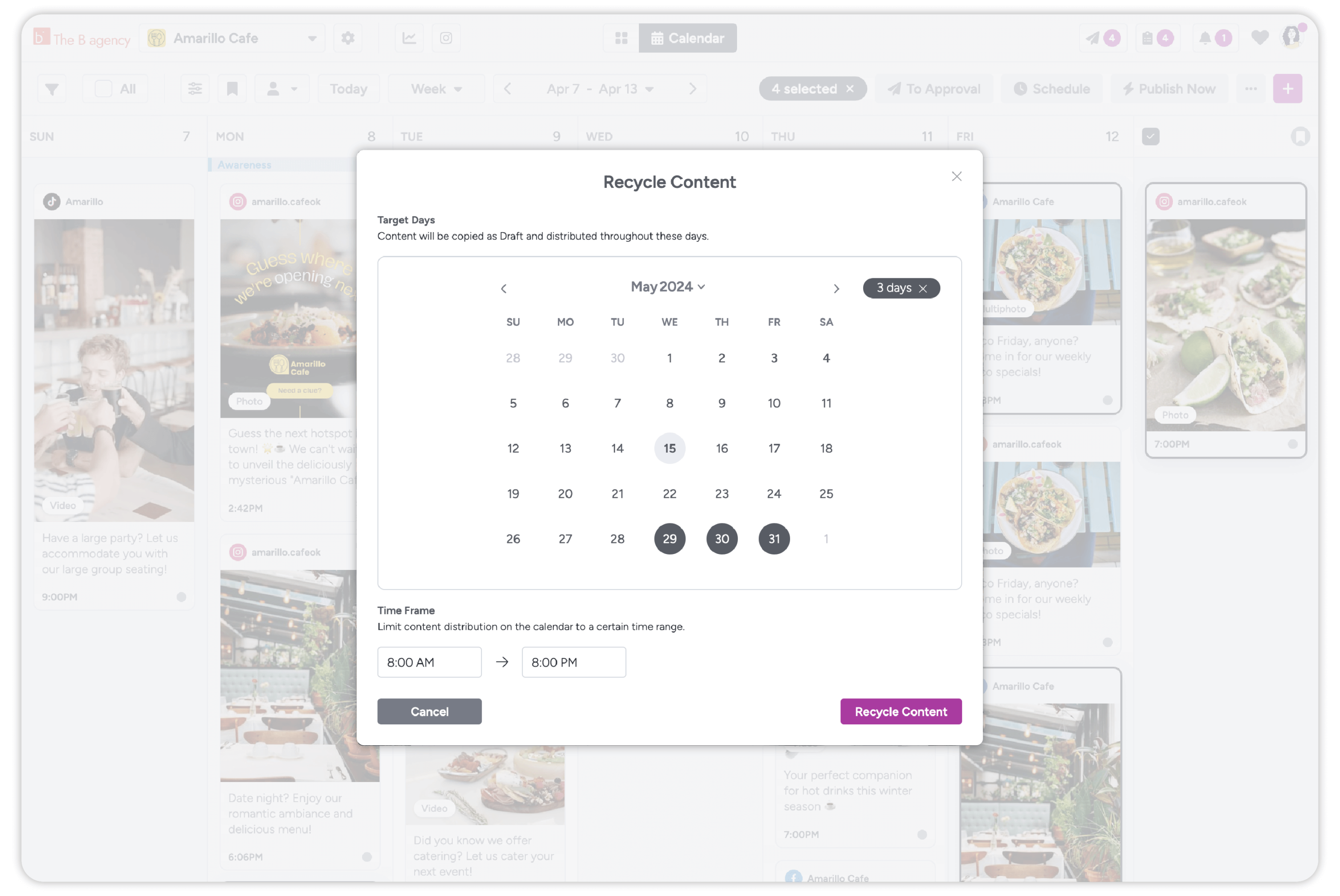
Other tools that are super handy for content repurposing are:
- Graphic Design Tools: For creating visuals like infographics and social media graphics, tools like Adobe Express, Canva, and Piktochart are invaluable. They offer templates and easy-to-use interfaces that can save time and maintain brand consistency.
- Video Editing Software: To convert written content into engaging videos, software like Adobe Premiere Pro and Final Cut Pro offer professional-grade editing features. For quicker, less intensive edits, tools like Camtasia or InVideo can be effective.
5. Execute, Monitor, Optimize
The real test of any content repurposing strategy comes with its execution and continuous improvement based on performance data. Don’t just recycle your best-performing pieces—you still need to monitor their performance and optimize your campaigns accordingly.
FAQs About Content Repurposing and Recycling
For social media, content that is visually appealing, emotionally engaging, or has previously sparked significant interaction tends to be most effective for repurposing. This includes popular infographics, video clips that have garnered high engagement, and posts with a lot of shares or comments.
For optimal results, strategically time your content repurposing to occur every three to four months, aligning it with your quarterly marketing goals. Additionally, consider repurposing when your analytics show high engagement or when it’s necessary to update content to keep up with current trends or incorporate new information.
Gain is an excellent tool for scheduling, publishing, and recycling content across various social media platforms. Using the platform’s analytics feature, you can identify your best-performing social media content and easily reshare it over a pre-selected date range.
Conclusion
Why reinvent the wheel when you can refine it? By breathing new life into content that works already, you can continue to engage your audience, attract new followers, and achieve your clients’ strategic goals with efficiency.
Ready to unlock long-term content repurposing? Make sure your agency is equipped with the right tools, like Gain, that can help you recycle social media content and achieve even better results for your clients.
Try Gain at no cost (no credit card required).



